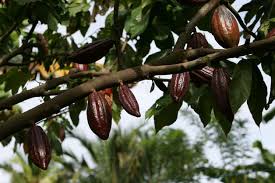
The scores of giant potholes that scar the roads from commercial capital Abidjan to Daloa in the heart of Ivory Coast’s cocoa belt have become deep, muddy puddles, filled by heavy tropical showers.
While drivers making the tortuous journey from the Atlantic coast into the hot interior have reason to curse the wet weather, for farmers in the world’s largest cocoa producer the rains mean the prospect of another record crop.
“We’ve got beneficial rains this season,” said Abdoulaye Baro, head of the Coopago cocoa cooperative in the town of Goudougo. “There’s lots of cocoa. This year it’s really good.”
The West African country’s crop will reach 2 million metric tons for the first time, according to a Bloomberg survey of six traders and exporters, breaking the previous record of 1.8 million tons set in 2014-15. In addition to lots of rain, the damaging dry winds that blow in from the Sahara desert were relatively weak this year. And it’s not just the right weather — growers have responded to years of high prices by planting trees that are now starting to produce beans.
While the country’s 800,000 smallholder cocoa farmers will have more beans than ever to sell to the commodity houses that supply the global confectionery industry, the bumper harvest risks tipping an already weak market into a full-blown slump. That’s a grave risk for the Ivorian economy, where cocoa is the biggest export earner.
This year’s worldwide surplus is expected to be more than 300,000 tons globally and a wave of defaults by buyers in the Ivory Coast have already helped send cocoa futures traded in London tumbling by about 30 percent since reaching a six-year high in July. The most-active cocoa contract was little changed at 1,688 pounds ($2,098) a ton on Tuesday.
“The price for cocoa beans in the world market has come down since late 2016 due to a large oversupply of beans,” said Filip Buggenhout, managing director of cocoa at Cargill Cocoa & Chocolate, a unit of the world’s largest agricultural trader. “What you are seeing here is the market dictating price, cocoa farmers in Ivory Coast recently received the highest incomes in recent history.”
At Goudougo, there’s so much moisture in the soil of the plantations farmed by the 417 members of Baro’s cooperative that even daytime temperatures above 30 degrees Celsius haven’t dried out the ground. Trees are full of flowers and small pods, a sign that there may still be a lot to harvest at the end part of the mid crop, the smaller of two annual harvests that takes place between April and September.
Production has also expanded in recent years as farmers moved into forested areas. In the village of Banfla, kilometers of cocoa plantations lie near the Sassandra river that runs through the western half of the country. It’s an area on the edge of the cocoa heartland, where farmers have deforested the Marahoue national park to produce more beans. The recent run of high prices, coupled with the deterioration of soil in more traditional cocoa areas, have spread growing to even more remote parts of the country, especially in the nation’s far west.
To be sure, not all areas of Ivory Coast have had favorable rains. At the Coop Socags in Soubre, flowers and small pods that would be harvested during the mid-crop are scarce. While there’s quite a bit of cocoa being fermented and dried, few large pods are left on the trees. The eastern part of Ivory Coast has also been drier, with rainfall at 50 percent to 75 percent of normal, according to MDA Weather Services.
The weakening global cocoa market may also have an impact.
Production may fail to reach 2 million tons as a cut of 36 percent to the price paid to farmers for the mid-crop will reduce incentive for farmers to pick every single pod on trees and also lower farm husbandry and the use of fertilizers, Cocoanect said in a report Wednesday.
“In addition, more cocoa will flow to neighboring countries, especially Ghana,” which has said it will keep prices stable, said the Rotterdam-based trader. “We might also see cocoa being withheld towards the end of the season if it looks likely that we could see a rise again in farm gate prices for the 2017-18 season.”
At the town of Meagui, in the country’s southwest, flowers are back on trees and farmers say rains have been good and production for the mid-crop is promising. Wet weather will help them harvest bigger beans for this crop — about 120 beans per kilogram compared with 150 to 180 last year.
“This year, rains have favored crops and the small harvest will be more like the main one in terms of quality and bean size,” said Kone Tiegbato, director of the USCM COOP-CA, a union of cooperatives at Meagui.
While it’s too early to forecast production for next season, analysts believe the market has entered a period of structural surpluses. Tropical Research Services, which advises several hedge funds, expects excess supply of more than 300,000 tons this season and the next.
For Ivory Coast, new trees coming into production will help keep output buoyant in the absence of severe weather events. After four years of rising prices, many farmers are also replanting new varieties, which can reach production in 18 months instead of the regular five years.
“Production is forecast at 1.9 million tons but it’s not excluded that Ivory Coast reaches 2 million tons,” Jean-Marc Anga, executive director at the International Cocoa Organization, said in an interview in Abidjan. “We usually issue quite conservative figures.”
(c) 2017, Bloomberg · Isis Almeida, Baudelaire Mieu, Olivier Monnier

